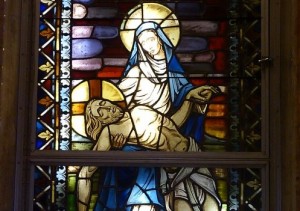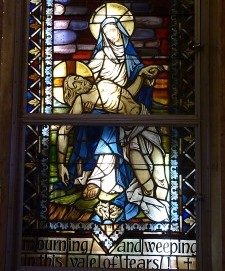Lacrimarum Valle—The Vale of Tears
 In the English translation of the Marian Antiphon, the Salve Regina, the word vale is used to indicate our current situation—our existence within a vale of tears. The pronunciation of this word differs between priests, seminarians, consecrated men and women, and the laity throughout the country. I have heard it pronounced similar to the word “valley” while at other times, one could hear the word “veil.”
In the English translation of the Marian Antiphon, the Salve Regina, the word vale is used to indicate our current situation—our existence within a vale of tears. The pronunciation of this word differs between priests, seminarians, consecrated men and women, and the laity throughout the country. I have heard it pronounced similar to the word “valley” while at other times, one could hear the word “veil.”
What is the correct interpretation and meaning behind this word contained within one of the most common Marian antiphons, and moreover, what is the correct pronunciation? These questions can be answered from three different perspectives: lexically, biblically, and artistically.
Lexically
The word used in the Latin is “valle” which, when defined using a Latin-English dictionary, means valley or vale. The English word veil is translated in Latin as velamen or velaminis in Latin, thus we can conclude there is a difference in the translation of the Latin-English between vale and veil. According to Merriam-Webster, the correct pronunciation of the English word vale would be \v-ay-l\. Audibly, this phonetic representation would sound like “veil” and would not be pronounced valley. It is probable that the word vale is more poetic and a synonym for the English word valley and a cognate of the Latin word valle.
Biblically
Of the 150 Psalms, one of the more popular psalms would be Psalm 23 [1] in which we acknowledge the Lord as our shepherd. Contained within this psalm is a similar allusion to the phrase “vale of tears” when the psalmist writes, “even though I walk through a dark valley, I fear no harm for you are at my side.” [2] The New American Bible provides a cross reference to Job 10:21-22, where the author writes: “Before I go whence I shall not return, to the land of darkness and of gloom, The dark, disordered land where darkness is the only light.” It appears that the scriptures, both Psalm 23 and Job, refer to this life as a dark valley because of the hope we have in the place of illuminant light in heaven.
Everything in this life, outside of Holy Mass, pales in comparison to the expectation and promise of eternal life. When we pray in the Hail Holy Queen, “to thee do we send up our sighs, mourning, and weeping, in this valley of tears,” we acknowledge the suffering our experiences in this life, by asking Mary as our intercessor to offer our troubles to the Lord, so in return, she can be a mediator of grace for us. Furthermore, the idea of a vale of tears could be representative of the cries of souls contained within Purgatory—to Mary they send their sighs, mourning, and weeping, because they are in a valley of tears and long to be united with Jesus in Heaven.
Artistically
At the National Shrine of Mary, Help of Christians, more commonly known as Holy Hill, in Hubertus, Wisconsin, the chapel dedicated to the Madonna contains stained glass windows depicting images of the Salve Regina. Their image depicting the vale of tears contains a pieta-like image of Mary and Jesus in a green and grassy area; also, in the horizon one will also notice a mountain and at the front of the image, the edge of a cliff. The grassy area then is a valley, located between two hills or mountains.
Conclusion
From a lexical, biblical, and artistic perspective, the best interpretation of the English word vale, pronounced similar to the word “veil,” is that of a valley of tears. The word vale should not be confused with a veil drenched in the tears of the Virgin because of her Son’s sorrowful Passion and death or as a result of the sins of her children. Rather, it is symbolic of our pilgrimage to the Heavenly Jerusalem, filled with both joyful and sorrowful moments, which we surrender to the Lord through Mary’s intercession. When our life breath leaves us, Mary will show us her Son Christ Jesus [3], and we know that at that time we will be in a place where there is no weeping, but constant praise of the Triune God for all eternity, where there will be a life-giving stream of water, instead of a vale of tears.
—–
Footnotes
[1] Depending upon the breakdown of the Psalms, this psalm could be the 22nd psalm.
[2] The New American Bible footnote indicates another Hebrew translation is the more common “the valley of the shadow of death.”
[3] From the song, “Hail Holy Queen Enthroned Above,” verse 3.
Image credit: Stained Glass Window at Holy Hill. Courtesty of Mary Anne Urlakis, http://salvematerdei.com/.


